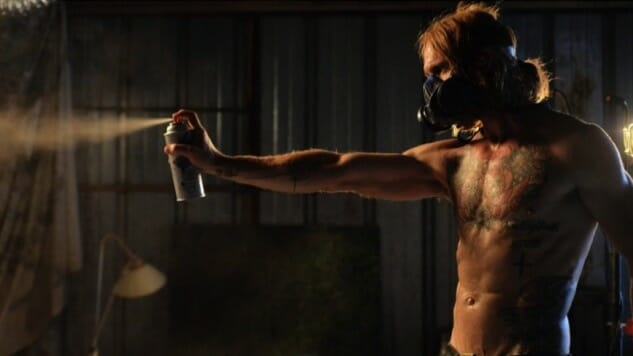
The set-up of The Devil’s Candy—Australian filmmaker Sean Byrne’s follow-up to his 2009 CarriemeetsTexas Chain Saw Massacre riff The Loved Ones—suggests a cross between the haunted house and serial killer subgenres. The movie centers on a child murderer, Ray (Pruitt Taylor Vince), escaping the house that Jesse (Ethan Embry), his wife Astrid (Shiri Appleby), and his daughter Zooey (Kiara Glasco) subsequently move into, not fully aware of the extent of the supernatural horrors contained within. And with Ray first seen playing loud chords on an electric guitar to drown out the voices in his head, and with Jesse characterized as a long-haired artist with a predilection for heavy metal, the film initially appears like it will play around with that connection between metal music and devil worship, with which many have often decried that particular musical genre.
The Devil’s Candy turns out to be more complicated than all that, though, in ways that are genuinely fascinating. Byrne’s film turns out to be less about heavy metal or even Satanism than about the psychological perils of artistic obsession. Jesse is first seen working on a canvas full of butterflies—a commission from a bank that is a far cry from the kinds of darker subjects he’d prefer to be working on… but, as he says to his similarly metal-loving daughter, it’s what pays the bills. But when he and his family move into this new house, the voices terrorizing Ray begin to prey upon Jesse, leading him to sustained periods in which he so completely loses himself in his work that only after he’s finished a canvas does he snap out of his spells and find himself both unsettled and exhilarated by the disturbing canvases he’s produced. It’s demonic possession as an expression of an artistic id taking flight, quashing any attempts Jesse makes to maintain a surface civility, especially when it comes to how he treats Zooey.
By comparison, Ray is a considerably less developed character. But considering the way Jesse’s artistic obsession converges with Ray’s more outwardly violent one—with one montage visually solidifying that psychic connection by juxtaposing close-ups of Jesse’s brushstrokes with those of blood being poured in the aftermath of Ray’s latest murder—Ray eventually comes off less a character than a symbol: Jesse’s artistic id made horrifyingly physical. This connection also suggests another buried idea in The Devil’s Candy: the potentially incinerating psychological effects on an artist of entering inside the mind of a disturbed individual, possibly even empathizing with him in unconscious ways. Fitting, then, that it all builds to a showdown between the two that takes place amid literal flames.
What makes The Devil’s Candy work beyond its allegorical ambitions is its refreshing attention to characterization, to the point where you respond to the people on screen as flesh-and-blood human beings rather than just cannon fodder. Much credit for this goes not only to Byrne’s writing, but to Embry, who imbues Jesse with equal parts sensitivity and a machismo that can occasionally veer into the terrifyingly imposing. Beyond just his fondness for heavy metal and his shoulder-length hair, he’s completely credible as both loving father and obsessive artist. Embry’s scenes with an equally terrific Glasco, especially, exude a warmth that makes those demon-possessed moments in which he fails his daughter even more heartbreaking. The Devil’s Candy is as much about one father’s paternal anxieties as it is about an artist teetering on the edge of losing his soul. It is, in other words, the kind of horror film that transcends genre and reaches that rare but exalted sweet spot of touching on genuine human fears.
Director: Sean Byrne
Writer: Sean Byrne
Starring: Ethan Embry, Shiri Appleby, Kiara Glasco, Pruitt Taylor Vince, Craig Nigh, Marco Perella
Release Date: March 17, 2017
Kenji Fujishima is a freelance film critic, contributing to Slant Magazine, Brooklyn Magazine, The Playlist and the Village Voice. He is also Deputy Editor of Movie Mezzanine. When he’s not watching movies and writing and editing film criticism, he’s trying to absorb as much music, art, and literature as possible. He has not infrequently been called a “culture vulture” for that reason.